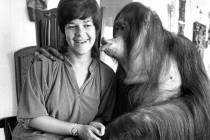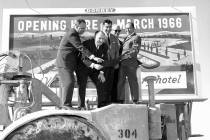Book reveals enduring stories from entertainer’s life weren’t made onstage
You think you know someone. Then you read his autobiography and realize how much you didn’t know. That’s how it is with William “Bob” Bailey.
When I first met Bob Bailey, he was a well-known Las Vegas civil rights leader, handsome, articulate, polite and forceful in his beliefs.
I knew he and wife Anna had been entertainers, that he had been the first black radio and television personality in Las Vegas starting in the ’50s. He became chairman of the first Nevada Equal Rights Commission in 1961 and a deputy director of the Minority Business Development Agency in the first Bush administration.
But there was so much more to discover in “Looking Up! Finding My Voice in Las Vegas.” Yes, it’s a story of the Baileys, who moved here in 1955 when they were 26. But he also tells personal memories of superstars such as Billie Holiday, Pearl Bailey, Count Basie, Josephine Baker, Sammy Davis Jr. and Louis Armstrong. He portrays a Las Vegas that no longer exists, painting pictures of Jackson Avenue on the Westside. Dirt streets and tumbleweeds, yet was oh so happening.
Three of his most vivid stories about racism in Las Vegas took place during the days of segregation, when black entertainers could perform, but had to come and go through the back door.
Bailey wrote: “One night when Nat was performing at the Sands, I tagged along with him and Al Freeman, the Sands’ publicity director, as they headed to the Tropicana. … But we were abruptly stopped at the front door by security and reminded that blacks were not welcome in the hotel. ‘Don’t you know who this is? This is Nat King Cole,’ Freeman protested.
“‘I don’t care if he is the black Jesus, he can’t come in,’ the guard snapped.”
A second tale featured dancer Josephine Baker, who played the El Rancho Vegas and noticed no blacks in the audience. Between shows, she learned of the segregation policies and told the owner, “If I don’t see some black faces in the audience for my second show, there will not be another show.”
The owner called Bailey, who was well-known because of his television and radio shows and asked how to get blacks into the second show.
Bailey suggested the owner tell some of his maids and porters to hurry home, change into their best clothes and come back for the show. It worked. Blacks attended Baker’s show for the rest of her run.
A third incident involved the woman whose name is on the humanities building at UNLV: Flora Dungan.
Flora was the financial officer at the Fremont Hotel and there was a television studio on the second floor where Bailey worked. At the time, Bailey couldn’t enter the front door and couldn’t eat in the coffee shop.
One day, Flora asked him to join her for lunch. “It was as ‘unacceptable’ for me to be in the coffee shop as to be seen in public with a white woman,” Bailey wrote. But he agreed. At first, they weren’t seated. Then after Flora seized an empty table, they weren’t served.
“Flora was burning, angrier than I. Here was someone facing discrimination for the first time, someone who wouldn’t normally be in this position,” Bailey wrote. Flora found a pit boss and they were served that day. The next day, Bailey learned he would no longer have to enter the Fremont through the service entrance.
No marches, no pickets, no lawsuits, yet he won.
His book is published by Stephens Press, a sister company to the Review-Journal, but that doesn’t mean I’m shilling. It’s a great read if you’re interested in entertainment and history.
Bob and Anna, married 58 years, are both 82. He speaks slowly, but communicates well, which is what Anna, then a dancer, first found attractive about the vibrant young singer with the Count Basie Orchestra.
Over two hours, we discuss issues including education, banking, job opportunities, and the F Street closure. He talks about his upcoming award from the Public Education Foundation on Sept. 12 and how proud he is to have a middle school carry his name.
Bob Bailey was one of many who made it possible for blacks to enter through the front door of Las Vegas casinos, a hard-earned freedom worth celebrating this Fourth of July.
Jane Ann Morrison’s column appears Monday, Thursday and Saturday. E-mail her at Jane@reviewjournal.com or call (702) 383-0275. She also blogs at lvrj.com/blogs/morrison/.












